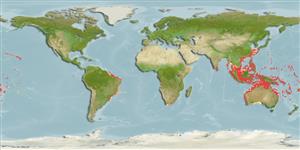Teleostei (teleosts) >
Tetraodontiformes (Puffers and filefishes) >
Diodontidae (Porcupinefishes (burrfishes))
Etymology: Diodon: Greek, di = two + Greek, odous = teeth (Ref. 45335).
Eponymy: Joseph Fortuné Théodore Eydoux (1802–1841) was a French naturalist who became a naval surgeon (1821). [...] (Ref. 128868), visit book page.
Environment: milieu / climate zone / depth range / distribution range
Ecology
Marine; pelagic-neritic; depth range 1 - ? m (Ref. 58302). Tropical; 31°N - 37°S, 50°W - 154°W
Circumtropical.
Size / Weight / Age
Maturity: Lm ? range ? - ? cm
Max length : 27.0 cm TL male/unsexed; (Ref. 4423)
Pelagic throughout its life history (Ref. 592, 48637). A schooling species. Feeds on larger zooplankton and fish larvae (Ref. 9680, 48637).
Life cycle and mating behavior
Maturity | Reproduction | Spawning | Eggs | Fecundity | Larvae
Leis, J.M., 2001. Diodontidae. Porcupine fishes (burrfishes). p. 3958-3965. In K.E. Carpenter and V. Niem (eds.) FAO species identification guide for fishery purposes. The living marine resources of the Western Central Pacific. Vol. 6. Bony fishes part 4 (Labridae to Latimeriidae), estuarine crocodiles. FAO, Rome. (Ref. 9680)
IUCN Red List Status (Ref. 130435: Version 2024-1)
Threat to humans
Harmless
Human uses
Fisheries: minor commercial
Tools
Special reports
Download XML
Internet sources
Estimates based on models
Preferred temperature (Ref.
123201): 23.1 - 29.1, mean 28 °C (based on 1936 cells).
Phylogenetic diversity index (Ref.
82804): PD
50 = 0.5313 [Uniqueness, from 0.5 = low to 2.0 = high].
Bayesian length-weight: a=0.04677 (0.01905 - 0.11483), b=2.82 (2.61 - 3.03), in cm total length, based on LWR estimates for this (Sub)family-body shape (Ref.
93245).
Trophic level (Ref.
69278): 3.7 ±0.51 se; based on food items.
Resilience (Ref.
120179): High, minimum population doubling time less than 15 months (Preliminary K or Fecundity.).
Fishing Vulnerability (Ref.
59153): Low vulnerability (17 of 100).
